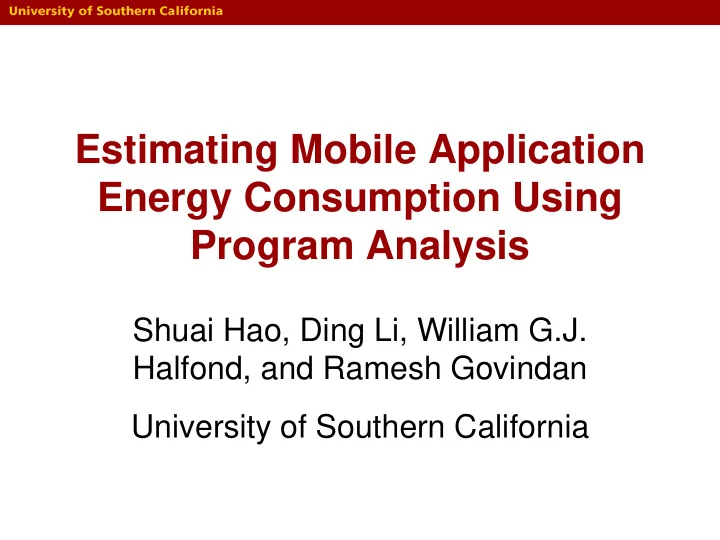

Estimating Mobile Application Energy Consumption Using Program Analysis Shuai Hao, Ding Li, William G.J. Halfond, and Ramesh Govindan University of Southern California
Motivation • Smartphones are popular • Batteries don’t last that long • Many user complaints Help app developers understand energy implications of their implementation choices 2
Related Approaches 1. Underlying hardware/OS improvements 2. Cycle-accurate simulators 3. Field measurements 4. Whole program/method level feedback 3
eLens – Our Approach Combine program analysis and per instruction cost modeling 1. Lightweight → no OS changes or specialized hardware required 2. Fine- grained → feedback at the source line level 3. Accurate → within 10% of ground truth 4. Fast → e stimates within minutes 4
Overview of eLens 1 1. Generate workload 2. Identify 2 corresponding 4 executed paths 3 3. Compute power values for paths 4. Annotate source lines 5
Generating the Workload Convert use cases to paths • Use cases represent scenarios of interest to the developers • Specified informally or formally • Our approach: run instrumented version of the app and record runtime information 6
Estimating a Path’s Energy Energy = 𝑫 𝒊 (𝒋) 𝒊∈𝑰𝒃𝒔𝒆𝒙𝒃𝒔𝒇 𝒋 ∈ 𝒒𝒃𝒖𝒊 • Cost functions (C h ) for each component (h) • Instruction’s energy cost is either: – Path- independent: “fixed - cost” energy – Path-dependent: varies based on path • Cost functions provided by a Software Environment Energy Profile (SEEP) 7
Software Environment Energy Profile Provides platform-specific energy parameters • Enables rapid analysis for multiple platforms • LEAP based profiling – Runs Android 3.2 – Samples at 10KHz – Synchronization pulses – Multiple hardware components 8
Instructions: Path-Independent “Fixed - cost” instructions • Energy varies by hardware component and power state • Profiled on LEAP node 1. Invokes/Returns 4. Stack management 2. Load/Stores 5. Jumps/Branches 3. Arithmetic/Logic 6. Fixed-cost APIs 9
Instructions: Path-dependent Based on information from other instructions in the path • Four general categories: 1. Array allocation 3. Implementing class 2. Argument data 4. External data • Propagate certain types of information along paths 10
Example Energy Calculation Cost Functions (nJ) ID Instruction CPU RAM WiFi 0 aload_0 1 1 .5 1 arraylength 1 1 .5 2 iconst_2 1 1 .5 3 if_icmpeq 14 2 1 .5 getstatic “ Network.out ” 6 2 1 .5 ldc “Usage…” 9 1 1 .5 11 invokevirtual “ println ” 20 10 10 14 return 1 1 .5 11
Visualization 12
Evaluation RQ1 : What is the accuracy of the energy estimates? RQ2 : How much time is needed to estimate the energy consumption? RQ3 : Is time profiling equivalent to energy estimation? 13
Challenges to Obtain Ground Truth 1. Apps compatible with LEAP node 2. LEAP sampling interval 3. Idle time dominates execution time 4. Isolation of application energy 14
Subject Applications App Classes Methods Bytecodes Description BBC Reader 590 4,923 293,910 RSS Reader for BBC News Bubble Blaster II 932 6,060 398,437 Bubble blasting game Classic Alchemy 751 4,434 467,099 Science game Location 428 3,179 232,898 Provide location Skyfire 684 3,976 274,196 Web browser Textgram 632 5,315 244,940 Text editor 15
Accuracy: App Level eLens differs from Ground Truth, on average, 8.8% Subject Applications 16
Accuracy: Method Level eLens differs from Ground Truth, on average, 7.1% Method Names 17
Accuracy: Hardware Components No more than 12% difference from Ground Truth Error Rate (%) Application CPU RAM WiFi GPS BBC Reader -6.2 5.9 -6.8 - Bubble Blaster II -11.5 3.5 -11.6 - Classic Alchemy -7.9 -6.9 -4.4 - Location -7.8 -8.4 - 8.1 Skyfire -7.9 0.9 -8.4 - Textgram 5.2 4.6 4.6 - 18
Runtime of eLens Runtime (s) Application Instr. Est. Runtime Breakdown BBC Reader 344 16 3% Bubble Blaster II 450 17 Classic Alchemy 886 17 Location 274 10 Skyfire 258 8 97% Textgram 269 6 Runtime ranged from 5 to 15 minutes 19
Is Time Equal to Energy? Compare methods’ time vs. energy – Linear correlation? → Pearson == 0 – Ranking similarity? → Cosine similarity == .21 Strong indication of no linear relationship or ranking similarity. 20
Conclusions • eLens → estimate energy consumption – Uses program analysis and per-instruction cost modeling – Imposes minimal requirements on developer • Evaluation – Accuracy was 8.8% at whole program level 21
Thank you 22
Case Study of Usefulness 23
Working with Market Apps instrumentation APK APK JVM JVM Bytecode Bytecode manifest.xml manifest.xml classes.dex classes.dex eLens Lib resources resources libs libs 24
Bytecode Costs 25
Time vs. Energy
Recommend
More recommend